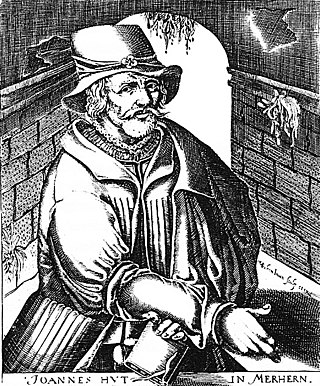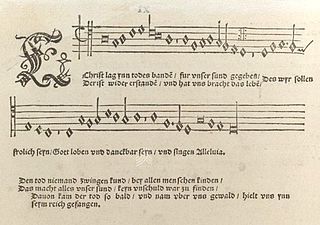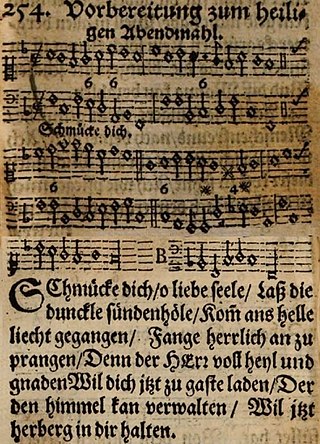
Kindertotenlieder is a song cycle (1904) for voice and orchestra by Gustav Mahler. The words of the songs are poems by Friedrich Rückert.

Judith Holfelder-Roy, known by her stage name Judith Holofernes, is a German singer, guitarist, songwriter and author.

Hans Hut was a very active Anabaptist in southern Germany and Austria.

The First Lutheran hymnal, published in 1524 as Etlich Cristlich lider / Lobgesang und Psalm, often also often referred to as the Achtliederbuch, was the first Lutheran hymnal.

The Erfurt Enchiridion is the second Lutheran hymnal. It appeared in 1524 in Erfurt in two competing editions. One of them contains 26 songs, the other 25, 18 of them by Martin Luther, others by Elisabeth Cruciger, Erhard Hegenwald, Justus Jonas and Paul Speratus. While the songs of the Enchiridion could be used in churches, they were intended primarily for singing elsewhere, such as at home, at court, and in guild meetings.

Praxis pietatis melica is a Protestant hymnal first published in the 17th century by Johann Crüger. The hymnal, which appeared under this title from 1647 to 1737 in 45 editions, has been described as "the most successful and widely-known Lutheran hymnal of the 17th century". Crüger composed melodies to texts that were published in the hymnal and are still sung today, including "Jesu, meine Freude", "Herzliebster Jesu", and "Nun danket alle Gott". Between 1647 and 1661, Crüger first printed 90 songs by his friend Paul Gerhardt, including "O Haupt voll Blut und Wunden".

Eyn geystlich Gesangk Buchleyn, was the first German hymnal harmonised for choir, published in Wittenberg in 1524 by Johann Walter who collaborated with Martin Luther. It contains 32 sacred songs, including 24 by Luther, in settings by Walter for three to five parts with the melody in the tenor. Luther wrote a preface for the part books. The collection has been called the root of all Protestant song music.

"Gott sei gelobet und gebenedeiet" is a Lutheran hymn of 1524 with words written by Martin Luther who used an older first stanza and melody. It is a song of thanks after communion. Luther's version in three stanzas was printed in the Erfurt Enchiridion of 1524 and in Johann Walter's choral hymnal Eyn geystlich Gesangk Buchleyn the same year. Today, the song appears in German hymnals, including both the Protestant Evangelisches Gesangbuch, and in a different version in the Catholic Gotteslob.
"Straf mich nicht in deinem Zorn" is a Lutheran hymn with a text written by Johann Georg Albinus as a paraphrase of Psalm 6. It was first printed with a formerly secular melody in Dresden in 1694. The song was included in 31 hymnals. The melody inspired musical settings both for organ and vocal works. The hymn was translated by Catherine Winkworth as "Not in anger, Mighty God", which appeared in 13 hymnals.
Georg Thurmair was a German poet who wrote around 300 hymns, a writer, journalist and author of documentary films.

"Schmücke dich, o liebe Seele" is a Lutheran hymn in German, with lyrics by Johann Franck and a hymn tune by Johann Crüger. It was first published in Crüger's 1649 Geistliche Kirchen-Melodien, and was later adopted in other hymnals, such as the 1653 edition of his Praxis pietatis melica.

"Ach lieben Christen seid getrost" is a Lutheran hymn in German with lyrics by Johannes Gigas, written in 1561. A penitential hymn, it was the basis for Bach's chorale cantata Ach, lieben Christen, seid getrost, BWV 114.

"Zu Bethlehem geboren" is a German Christmas carol. The text is attributed to Friedrich Spee, and was first printed in the collection Geistlichen Psälterlein by Johannes Heringsdorf in Cologne in 1637. The author was unknown until the 20th century, but research of style and content arrived at the attribution. The song was printed with a then-popular secular melody in 1638. The song appears in current Catholic and Protestant hymnals.

"Das Grab ist leer, der Held erwacht" is a Catholic hymn for Easter, first printed in 1777 in the hymnal Landshuter Gesangbuch published by Franz Seraph von Kohlbrenner. Keeping only the first of five stanzas, with additional two stanzas, it appeared in hymnals of the 19th century, and later in different versions in several regional sections of the Catholic hymnal Gotteslob. It is a frequently sung hymn in Easter services.

"Nun, Brüder, sind wir frohgemut" is a German Catholic hymn. It was written by Georg Thurmair as both a pilgrimage song and a Marian hymn. The melody was composed by Adolf Lohmann, who wrote a choral setting in 1936. Related to youth pilgrimages to an image of Mary at the Altenberger Dom, it is also known as "Altenberger Wallfahrtslied". The song is regarded as an Oppositionelles Lied, in subtle protest against the Nazi regime.
Hymnody in continental Europe developed from early liturgical music, especially Gregorian chant. Music became more complicated as embellishments and variations were added, along with influences from secular music. Although vernacular leisen and vernacular or mixed-language carols were sung in the Middle Ages, more vernacular hymnody emerged during the Protestant Reformation, although ecclesiastical Latin continued to be used after the Reformation. Since then, developments have shifted between isorhythmic, homorhythmic, and more rounded musical forms with some lilting. Theological underpinnings influenced the narrative point of view used, with Pietism especially encouraging the use of the first person singular. In the last several centuries, many songs from Evangelicalism have been translated from English into German.
"Nun liebe Seel, nun ist es Zeit", alternatively written "Nun, liebe Seel, nun ist es Zeit", is a Lutheran hymn for Epiphany, in five stanzas of six lines each, by Georg Weissel. It was first printed in 1642, set as a motet by Johannes Eccard. A version with an additional stanza is attributed to Johann Christoph Arnschwanger.
"Freuet euch der schönen Erde" is a Lutheran hymn in German with a text by Philipp Spitta in 1827. In the hymnal Evangelisches Gesangbuch, it appears as EG 510, with a 1928 melody by Frieda Fronmüller.
"O komm, du Geist der Wahrheit" is a Lutheran hymn for Pentecost in German. The text was written by Philipp Spitta, probably in 1827, and published in 1833 in the song collection Psalter und Harfe. It is a prayer to the Holy Spirit for courage to confession in a time poor in faith. The hymn which first appeared without a melody, is now usually sung to the 1529 melody of "Lob Gott getrost mit Singen". It is part of the current Protestant hymnal, and of other hymnals.














